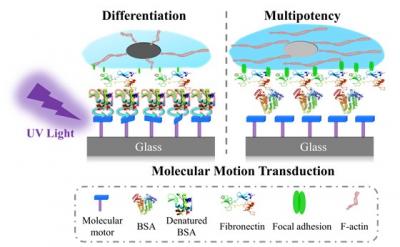Molecular motors direct the fate of stem cells

The movement of motor molecules interferes with the alpha-helices in the proteins, which causes structural changes. The change in the structure of the protein affects how the cells attach. This sets off a signaling cascade that eventually leads to altered behavior, such as the differentiation into bone cells. Thus, molecular movement leads to nanoscopic changes in surface structure, which in turn leads to differences in cell attachment, cell morphology and eventually, cell differentiation. Credit: Zhou et al, University of Groningen
'Cells are sensitive to the structure of the surface that they attach to,' explains Patrick van Rijn, associate professor in Materiobiology and Nanobiomaterials. 'And movement is an important driver in biology, especially continuous movement.'
That is why Van Rijn and Feringa and their colleagues decided to use molecular motors to manipulate the protein matrix on which stem cells are grown. The light-driven motor molecules were designed by the 2016 Nobel Laureate in Chemistry Ben Feringa.
Structural changes
The scientists linked molecular motors to a glass surface. Subsequently, the surface was coated with protein and either exposed to UV irradiation to power the motors or not exposed to it at all. After about an hour, the motor movement was stopped and cells were seeded onto the protein layer and left to attach.
Finally, differentiation factors were added. These experiments showed that cells grown on protein that was submitted to the rotary motion of the molecular motors tended to specialize into bone cells more often, while cells seeded on protein that was not disturbed were more inclined to maintain their stem-cell properties.
Observations of the protein layer using atomic force microscopy and simulations of the interaction between the motor molecules and proteins, performed by Prof. Marrink's research group, showed that the movement induced subtle structural changes in the protein matrix.
'The movement of motor molecules interferes with the alpha-helices in the proteins, which causes structural changes,' explains Van Rijn. He compares it to the difference in texture between an unwhipped egg white and a whipped one.
Cell fate
The change in the surface structure of the adhered protein affects how the cells attach, for example how much they stretch out. This sets off a signaling cascade that eventually leads to altered behavior, such as the differentiation into bone cells.
Thus, molecular movement leads to nanoscopic changes in surface structure, which in turn leads to differences in cell attachment, cell morphology and eventually, cell differentiation. 'It's like a domino effect, where smaller stones consecutively topple slightly larger ones so that a large effect can be achieved with a small trigger.'
'Changing the properties of a surface to affect cell fate has been used before,' says Van Rijn. However, this was done primarily with switches, so there was just a change from one state to another. 'In our study, we had continuous movement, which is much more in line with the continuous motion found in biological transport and communication systems.
The fact that the motors are driven by light is important,' Van Rijn adds. 'Light can be carefully controlled in space and time. This would allow us to create complex geometries in the growth matrix, which then result in different properties for the cells.' Therefore, light-controlled molecular motors could be a useful tool in tissue engineering.
Simple Science Summary
The surface on which cells are grown can affect their properties. Scientists have used molecular motors, which rotate when irradiated with light, to change the structure of a protein layer on which stem cells were seeded. These stem cells, derived from bone marrow, can form different cell types or they can remain stem cells. The movement of the motors primed the stem cells to transform more efficiently into bone cells. This technique could be used to dynamically control cellular behavior on surfaces and create complex cell layers and tissues with different cell types by changing the properties of the protein layer at specific places.
###
Reference: Qihui Zhou, Jiawen Chen, Yafei Luan, Petteri A. Vainikka, Sebastian Thallmair, Siewert J. Marrink, Ben L. Feringa, Patrick van Rijn: Unidirectional rotating molecular motors dynamically interact with adsorbed proteins to direct the fate of mesenchymal stem cells. Science Advances, 29 January 2020.
Media Contact
More Information:
http://dx.doi.org/10.1126/sciadv.aay2756All latest news from the category: Life Sciences and Chemistry
Articles and reports from the Life Sciences and chemistry area deal with applied and basic research into modern biology, chemistry and human medicine.
Valuable information can be found on a range of life sciences fields including bacteriology, biochemistry, bionics, bioinformatics, biophysics, biotechnology, genetics, geobotany, human biology, marine biology, microbiology, molecular biology, cellular biology, zoology, bioinorganic chemistry, microchemistry and environmental chemistry.
Newest articles

High-energy-density aqueous battery based on halogen multi-electron transfer
Traditional non-aqueous lithium-ion batteries have a high energy density, but their safety is compromised due to the flammable organic electrolytes they utilize. Aqueous batteries use water as the solvent for…

First-ever combined heart pump and pig kidney transplant
…gives new hope to patient with terminal illness. Surgeons at NYU Langone Health performed the first-ever combined mechanical heart pump and gene-edited pig kidney transplant surgery in a 54-year-old woman…

Biophysics: Testing how well biomarkers work
LMU researchers have developed a method to determine how reliably target proteins can be labeled using super-resolution fluorescence microscopy. Modern microscopy techniques make it possible to examine the inner workings…





















